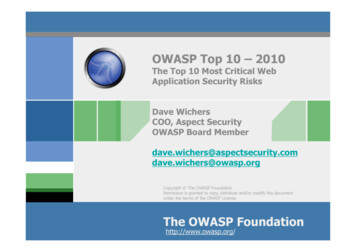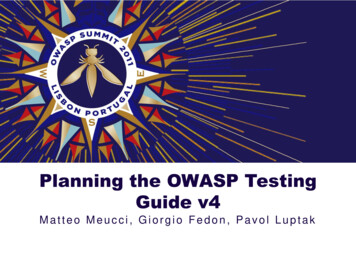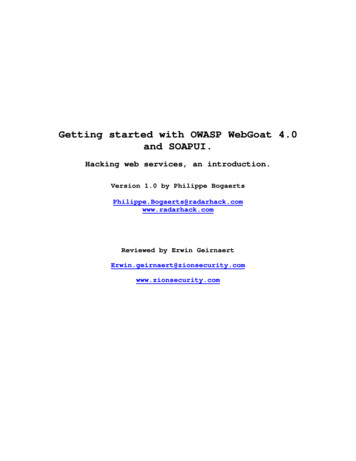
Transcription
OWASP Top 10 – 2010The Top 10 Most Critical WebApplication Security RisksDave WichersCOO, Aspect SecurityOWASP Board owasp.orgCopyright The OWASP FoundationPermission is granted to copy, distribute and/or modify this documentunder the terms of the OWASP License.The OWASP Foundationhttp://www.owasp.org/
What’s Changed?It’s About Risks, Not Just Vulnerabilities New title is: “The Top 10 Most Critical Web Application Security Risks”OWASP Top 10 Risk Rating Methodology Based on the OWASP Risk Rating Methodology, used to prioritize Top 102 Risks Added, 2 Dropped Added: A6 – Security Misconfiguration Was A10 in 2004 Top 10: Insecure Configuration Management Added: A10 – Unvalidated Redirects and Forwards Relatively common and VERY dangerous flaw that is not well known Removed: A3 – Malicious File Execution Primarily a PHP flaw that is dropping in prevalence Removed: A6 – Information Leakage and Improper Error Handling A very prevalent flaw, that does not introduce much risk (normally)OWASP - 2010
Mapping from 2007 to 2010 Top 10OWASP Top 10 – 2007 (Previous)OWASP Top 10 – 2010 (New)A2 – Injection FlawsA1 – InjectionA1 – Cross Site Scripting (XSS)A2 – Cross Site Scripting (XSS)A7 – Broken Authentication and Session ManagementA3 – Broken Authentication and Session ManagementA4 – Insecure Direct Object Reference A4 – Insecure Direct Object ReferencesA5 – Cross Site Request Forgery (CSRF) A5 – Cross Site Request Forgery (CSRF) was T10 2004 A10 – Insecure ConfigurationManagement A6 – Security Misconfiguration (NEW)A8 – Insecure Cryptographic StorageA7 – Insecure Cryptographic StorageA10 – Failure to Restrict URL AccessA8 – Failure to Restrict URL AccessA9 – Insecure Communications A9 – Insufficient Transport Layer Protection not in T10 2007 A10 – Unvalidated Redirects and Forwards (NEW)A3 – Malicious File ExecutionA6 – Information Leakage and Improper Error Handling- dropped from T10 2010 dropped from T10 2010 OWASP - 2010
OWASP Top 10 Risk Rating alenceWeaknessDetectabilityTechnical njection ExampleBusinessImpact?1.66 weighted risk ratingOWASP - 2010
OWASP Top Ten (2010 Edition)http://www.owasp.org/index.php/Top 10OWASP - 2010
A1 – InjectionInjection means Tricking an application into including unintended commands in the datasent to an interpreterInterpreters Take strings and interpret them as commands SQL, OS Shell, LDAP, XPath, Hibernate, etc SQL injection is still quite common Many applications still susceptible (really don’t know why) Even though it’s usually very simple to avoidTypical Impact Usually severe. Entire database can usually be read or modified May also allow full database schema, or account access, or even OS levelaccessOWASP - 2010
ATTACK Custom CodeBillingDirectories Acct:5424-9383-2039-4029Acct:4128-0004-1234-02933. Application forwards attack tothe database in a SQL queryWeb ServerFirewallHardened OSFirewallDB Table "SELECT * FROMAccount SummaryAccount:accounts WHERESKU:acct ‘’ 1 1--’"1. Application presents a form tothe attacker2. Attacker sends an attack in theform dataApp ServerNetwork LayerHuman Resrcs Web ServicesHTTPSQLresponsequery HTTPrequestAPPLICATIONLegacy SystemsDatabasesCommunicationKnowledge MgmtE-CommerceBus. Application LayerSQL Injection – Illustrated4. Database runs query containingattack and sends encrypted resultsback to application5. Application decrypts data asnormal and sends results to the userOWASP - 2010
A1 – Avoiding Injection Flaws Recommendations1. Avoid the interpreter entirely, or2. Use an interface that supports bind variables (e.g., preparedstatements, or stored procedures), Bind variables allow the interpreter to distinguish between code anddata3. Encode all user input before passing it to the interpreter Always perform ‘white list’ input validation on all user suppliedinput Always minimize database privileges to reduce the impact of aflaw References For more details, read the newhttp://www.owasp.org/index.php/SQL Injection Prevention Cheat SheetOWASP - 2010
A2 – Cross-Site Scripting (XSS)Occurs any time Raw data from attacker is sent to an innocent user’s browserRaw data Stored in database Reflected from web input (form field, hidden field, URL, etc ) Sent directly into rich JavaScript clientVirtually every web application has this problem Try this in your browser – javascript:alert(document.cookie)Typical Impact Steal user’s session, steal sensitive data, rewrite web page, redirect user tophishing or malware site Most Severe: Install XSS proxy which allows attacker to observe and directall user’s behavior on vulnerable site and force user to other sitesOWASP - 2010
Cross-Site Scripting IllustratedAttacker sets the trap – update my profileVictim views page – sees attacker profileCommunicationKnowledge MgmtE-CommerceBus. Functions2AdministrationTransactionsAttacker enters amalicious script into aweb page that stores thedata on the serverApplication withstored XSSvulnerabilityAccountsFinance1Custom CodeScript runs insidevictim’s browser with fullaccess to the DOM andcookies3Script silently sends attacker Victim’s session cookieOWASP - 2010
A2 – Avoiding XSS Flaws Recommendations Eliminate Flaw Don’t include user supplied input in the output page Defend Against the Flaw Primary Recommendation: Output encode all user supplied input(Use OWASP’s ESAPI to output encode:http://www.owasp.org/index.php/ESAPIPerform ‘white list’ input validation on all user input to be included inpageFor large chunks of user supplied HTML, use OWASP’s AntiSamy tosanitize this HTML to make it safeSee: http://www.owasp.org/index.php/AntiSamy References For how to output encode properly, read the newhttp://www.owasp.org/index.php/XSS (Cross Site Scripting) Prevention Cheat SheetOWASP - 2010(AntiSamy)
Safe Escaping Schemes in Various HTML ExecutionContexts#1: ( &, , , " ) &entity; ( ', / ) &#xHH;ESAPI: encodeForHTML()HTML Element Content(e.g., div some text to display /div )#2: All non-alphanumeric 256 &#xHHESAPI: encodeForHTMLAttribute()HTML Attribute Values(e.g., input name 'person' type 'TEXT'value 'defaultValue' )#3: All non-alphanumeric 256 \xHHESAPI: encodeForJavaScript()JavaScript Data(e.g., script some javascript /script )HTML Style Property Values#4: All non-alphanumeric 256 \HHESAPI: encodeForCSS()(e.g., .pdiv a:hover {color: red; text-decoration:underline} )URI Attribute Values#5: All non-alphanumeric 256 %HHESAPI: encodeForURL()(e.g., a href "javascript:toggle('lesson')" )ALL other contexts CANNOT include Untrusted DataRecommendation: Only allow #1 and #2 and disallow all othersSee: www.owasp.org/index.php/XSS (Cross Site Scripting) Prevention Cheat Sheet for moreOWASP - 2010details
A3 – Broken Authentication and SessionManagementHTTP is a “stateless” protocol Means credentials have to go with every request Should use SSL for everything requiring authenticationSession management flaws SESSION ID used to track state since HTTP doesn’t and it is just as good as credentials to an attacker SESSION ID is typically exposed on the network, in browser, in logs, Beware the side-doors Change my password, remember my password, forgot my password, secretquestion, logout, email address, etc Typical Impact User accounts compromised or user sessions hijackedOWASP - 2010
www.boi.com?JSESSIONID 9FA1DB9EA.Site uses URL rewriting(i.e., put session in URL)32Custom CodeUser clicks on a link to http://www.hacker.comin a forumHacker checks referer logs on www.hacker.comand finds user’s JSESSIONID5CommunicationKnowledge MgmtE-CommerceBus. FunctionsUser sends onsBroken Authentication Illustrated4Hacker uses JSESSIONIDand takes over victim’saccountOWASP - 2010
A3 – Avoiding Broken Authentication andSession Management Verify your architecture Authentication should be simple, centralized, and standardized Use the standard session id provided by your container Be sure SSL protects both credentials and session id at all times Verify the implementation Forget automated analysis approaches Check your SSL certificate Examine all the authentication-related functions Verify that logoff actually destroys the session Use OWASP’s WebScarab to test the implementation Follow the guidance from http://www.owasp.org/index.php/Authentication Cheat SheetOWASP - 2010
A4 – Insecure Direct Object ReferencesHow do you protect access to your data? This is part of enforcing proper “Authorization”, along withA7 – Failure to Restrict URL AccessA common mistake Only listing the ‘authorized’ objects for the current user, or Hiding the object references in hidden fields and then not enforcing these restrictions on the server side This is called presentation layer access control, and doesn’t work Attacker simply tampers with parameter valueTypical Impact Users are able to access unauthorized files or dataOWASP - 2010
Insecure Direct Object er?acct 6065 Attacker notices his acctparameter is 6065?acct 6065 He modifies it to anearby number?acct 6066 Attacker views thevictim’s accountinformationOWASP - 2010
A4 – Avoiding Insecure Direct ObjectReferences Eliminate the direct object reference Replace them with a temporary mapping value (e.g. 1, 2, 3) ESAPI provides support for numeric & random mappings IntegerAccessReferenceMap & RandomAccessReferenceMaphttp://app?file Report123.xlshttp://app?file 1http://app?id 9182374http://app?id 7d3J93AccessReferenceMapReport123.xlsAcct:9182374 Validate the direct object reference Verify the parameter value is properly formatted Verify the user is allowed to access the target object Query constraints work great! Verify the requested mode of access is allowed to the targetobject (e.g., read, write, delete)OWASP - 2010
A5 – Cross Site Request Forgery (CSRF)Cross Site Request Forgery An attack where the victim’s browser is tricked into issuing a command toa vulnerable web application Vulnerability is caused by browsers automatically including userauthentication data (session ID, IP address, Windows domain credentials, ) with each requestImagine What if a hacker could steer your mouse and get you to click on links inyour online banking application? What could they make you do?Typical Impact Initiate transactions (transfer funds, logout user, close account) Access sensitive data Change account detailsOWASP - 2010
CSRF Vulnerability Pattern The Problem Web browsers automatically include most credentials with eachrequest Even for requests caused by a form, script, or image on another site All sites relying solely on automaticcredentials are vulnerable! (almost all sites are this way) Automatically Provided Credentials Session cookie Basic authentication header IP address Client side SSL certificates Windows domain authenticationOWASP - 2010
CSRF IllustratedWhile logged into vulnerable site,victim views attacker siteCommunicationKnowledge MgmtE-CommerceBus. Functions2AdministrationTransactionsHidden img tagcontains attack againstvulnerable siteApplication with CSRFvulnerabilityAccountsFinance1Attacker sets the trap on some website on the internet(or simply via an e-mail)Custom Code3 img tag loaded bybrowser – sends GETrequest (includingcredentials) to vulnerablesiteVulnerable site seeslegitimate request fromvictim and performs theaction requestedOWASP - 2010
A5 – Avoiding CSRF Flaws Add a secret, not automatically submitted, token to ALL sensitive requests This makes it impossible for the attacker to spoof the request (unless there’s an XSS hole in your application) Tokens should be cryptographically strong or random Options Store a single token in the session and add it to all forms and links Hidden Field: input name "token" value "687965fdfaew87agrde"type "hidden"/ Single use URL: /accounts/687965fdfaew87agrde Form Token: /accounts?auth 687965fdfaew87agrde Beware exposing the token in a referer header Hidden fields are recommended Can have a unique token for each function Use a hash of function name, session id, and a secret Can require secondary authentication for sensitive functions (e.g., eTrade) Don’t allow attackers to store attacks on your site Properly encode all input on the way out This renders all links/requests inert in most interpretersSee the new: www.owasp.org/index.php/CSRF Prevention Cheat Sheetfor more detailsOWASP - 2010
A6 – Security MisconfigurationWeb applications rely on a secure foundation Everywhere from the OS up through the App Server Don’t forget all the libraries you are using!!Is your source code a secret? Think of all the places your source code goes Security should not require secret source codeCM must extend to all parts of the application All credentials should change in productionTypical Impact Install backdoor through missing OS or server patch XSS flaw exploits due to missing application framework patches Unauthorized access to default accounts, application functionality or data,or unused but accessible functionality due to poor server configurationOWASP - 2010
CommunicationKnowledge MgmtE-CommerceBus. Security Misconfiguration IllustratedDatabaseCustom CodeApp ConfigurationFrameworkDevelopmentApp ServerWeb ServerInsiderQA ServersHardened OSTest ServersSource ControlOWASP - 2010
A6 – Avoiding Security Misconfiguration Verify your system’s configuration management Secure configuration “hardening” guideline Automation is REALLY USEFUL here Must cover entire platform and application Keep up with patches for ALL components This includes software libraries, not just OS and Server applications Analyze security effects of changes Can you “dump” the application configuration Build reporting into your process If you can’t verify it, it isn’t secure Verify the implementation Scanning finds generic configuration and missing patch problemsOWASP - 2010
A7 – Insecure Cryptographic StorageStoring sensitive data insecurely Failure to identify all sensitive data Failure to identify all the places that this sensitive data gets stored Databases, files, directories, log files, backups, etc. Failure to properly protect this data in every locationTypical Impact Attackers access or modify confidential or private information e.g, credit cards, health care records, financial data (yours or yourcustomers) Attackers extract secrets to use in additional attacks Company embarrassment, customer dissatisfaction, and loss of trust Expense of cleaning up the incident, such as forensics, sending apologyletters, reissuing thousands of credit cards, providing identity theftinsurance Business gets sued and/or finedOWASP - 2010
1Victim enters creditcard number in nicationKnowledgeMgmtE-CommerceBus. FunctionsInsecure Cryptographic Storage IllustratedCustom Code4Log filesMalicious insidersteals 4 million creditcard numbersLogs are accessible to allmembers of IT staff fordebugging purposesError handler logs CCdetails because merchantgateway is unavailable3OWASP - 20102
A7 – Avoiding Insecure CryptographicStorage Verify your architecture Identify all sensitive dataIdentify all the places that data is storedEnsure threat model accounts for possible attacksUse encryption to counter the threats, don’t just ‘encrypt’ the data Protect with appropriate mechanisms File encryption, database encryption, data element encryption Use the mechanisms correctly Use standard strong algorithms Generate, distribute, and protect keys properly Be prepared for key change Verify the implementation A standard strong algorithm is used, and it’s the proper algorithm for this situationAll keys, certificates, and passwords are properly stored and protectedSafe key distribution and an effective plan for key change are in placeAnalyze encryption code for common flawsOWASP - 2010
A8 – Failure to Restrict URL AccessHow do you protect access to URLs (pages)? This is part of enforcing proper “authorization”, along withA4 – Insecure Direct Object ReferencesA common mistake Displaying only authorized links and menu choices This is called presentation layer access control, and doesn’t work Attacker simply forges direct access to ‘unauthorized’ pagesTypical Impact Attackers invoke functions and services they’re not authorized for Access other user’s accounts and data Perform privileged actionsOWASP - 2010
Failure to Restrict URL Access Illustrated Attacker notices the URLindicates his role/user/getAccounts He modifies it to anotherdirectory (role)/admin/getAccounts, or/manager/getAccounts Attacker views moreaccounts than just theirownOWASP - 2010
A8 – Avoiding URL Access Control Flaws For each URL, a site needs to do 3 things Restrict access to authenticated users (if not public) Enforce any user or role based permissions (if private) Completely disallow requests to unauthorized page types (e.g., config files, logfiles, source files, etc.) Verify your architecture Use a simple, positive model at every layer Be sure you actually have a mechanism at every layer Verify the implementation Forget automated analysis approaches Verify that each URL in your application is protected by either An external filter, like Java EE web.xml or a commercial product Or internal checks in YOUR code – Use ESAPI’s isAuthorizedForURL() method Verify the server configuration disallows requests to unauthorized file types Use WebScarab or your browser to forge unauthorized requestsOWASP - 2010
A9 – Insufficient Transport Layer ProtectionTransmitting sensitive data insecurely Failure to identify all sensitive data Failure to identify all the places that this sensitive data is sent On the web, to backend databases, to business partners, internalcommunications Failure to properly protect this data in every locationTypical Impact Attackers access or modify confidential or private information e.g, credit cards, health care records, financial data (yours or yourcustomers) Attackers extract secrets to use in additional attacks Company embarrassment, customer dissatisfaction, and loss of trust Expense of cleaning up the incident Business gets sued and/or finedOWASP - 2010
Insufficient Transport Layer ProtectionIllustratedBusiness PartnersExternal VictimCustom Code1External attackersteals credentialsand data offnetworkExternal AttackerBackend Systems2EmployeesInternal attackersteals credentialsand data frominternal networkInternal AttackerOWASP - 2010
A9 – Avoiding Insufficient Transport LayerProtection Protect with appropriate mechanisms Use TLS on all connections with sensitive data Individually encrypt messages before transmission E.g., XML-Encryption Sign messages before transmission E.g., XML-Signature Use the mechanisms correctly Use standard strong algorithms (disable old SSL algorithms) Manage keys/certificates properly Verify SSL certificates before using them Use proven mechanisms when sufficient E.g., SSL vs. XML-Encryption See: http://www.owasp.org/index.php/Transport Layer Protection CheatSheet for more detailsOWASP - 2010
A10 – Unvalidated Redirects and ForwardsWeb application redirects are very common And frequently include user supplied parameters in the destination URL If they aren’t validated, attacker can send victim to a site of theirchoiceForwards (aka Transfer in .NET) are common too They internally send the request to a new page in the same application Sometimes parameters define the target page If not validated, attacker may be able to use unvalidated forward tobypass authentication or authorization checksTypical Impact Redirect victim to phishing or malware site Attacker’s request is forwarded past security checks, allowingunauthorized function or data accessOWASP - 2010
Unvalidated Redirect IllustratedAttacker sends attack to victim via email or webpageE-CommerceBus. FunctionsKnowledge MgmtTransactionsVictim clicks link containing unvalidatedparameterCommunicationApplication redirectsvictim to attacker’s siteAccounts23AdministrationFrom: Internal Revenue ServiceSubject: Your Unclaimed Tax RefundOur records show you have anunclaimed federal tax refund. Pleaseclick here to initiate your claim.Finance1Custom CodeRequest sent to vulnerablesite, including attacker’sdestination site as parameter.Redirect sends victim toattacker sitehttp://www.irs.gov/taxrefund/claim.jsp?year 2006& &dest www.evilsite.comEvil Site4Evil site installs malware onvictim, or phish’s for privateinformationOWASP - 2010
Unvalidated Forward Illustrated1Attacker sends attack to vulnerable page they have access toRequest sent tovulnerable page whichuser does have access to.Redirect sends userdirectly to private page,bypassing access control.2Application authorizesrequest, which continuesto vulnerable pagepublic voidsensitiveMethod( HttpServletRequestrequest, HttpServletResponseresponse) {try {// Do sensitive stuff here.}catch ( .Filter3public void doPost( HttpServletRequest request,HttpServletResponse response) {try {String target request.getParameter( "dest" ) );.Forwarding page fails to validateparameter, sending attacker tounauthorized page, bypassing accesscontrolrequest.getRequestDispatcher( target ).forward(request, response);}catch ( .OWASP - 2010
A10 – Avoiding Unvalidated Redirects andForwards There are a number of options1. Avoid using redirects and forwards as much as you can2. If used, don’t involve user parameters in defining the target URL3. If you ‘must’ involve user parameters, then eithera) Validate each parameter to ensure its valid and authorized for the current user, orb) (preferred) – Use server side mapping to translate choice provided to user with actualtarget page Defense in depth: For redirects, validate the target URL after it is calculated tomake sure it goes to an authorized external site ESAPI can do this for you!! See: SecurityWrapperResponse.sendRedirect( URL ) http://owasp-esapi-java.googlecode.com/svn/trunk e.html#sendRedirect(java.lang.String) Some thoughts about protecting Forwards Ideally, you’d call the access controller to make sure the user is authorizedbefore you perform the forward (with ESAPI, this is easy) With an external filter, like Siteminder, this is not very practical Next best is to make sure that users who can access the original page are ALLauthorized to access the target page.OWASP - 2010
Summary: How do you address theseproblems? Develop Secure Code Follow the best practices in OWASP’s Guide to Building Secure WebApplications http://www.owasp.org/index.php/Guide Use OWASP’s Application Security Verification Standard as a guide towhat an application needs to be secure http://www.owasp.org/index.php/ASVS Use standard security components that are a fit for your organization Use OWASP’s ESAPI as a basis for your standard components http://www.owasp.org/index.php/ESAPI Review Your Applications Have an expert team review your applications Review your applications yourselves following OWASP Guidelines OWASP Code Review Guide:http://www.owasp.org/index.php/Code Review Guide OWASP Testing Guide:http://www.owasp.org/index.php/Testing GuideOWASP - 2010
OWASP (ESAPI)Custom Enterprise Web ApplicationYour Existing Enterprise Services or LibrariesESAPI Homepage: http://www.owasp.org/index.php/ESAPIOWASP - ception ontrollerUserAuthenticatorOWASP Enterprise Security API
Acknowledgements We’d like to thank the Primary Project Contributors Aspect Security for sponsoring the project Jeff Williams (Author who conceived of and launched Top 10 in 2003) Dave Wichers (Author and current project lead) Organizations that contributed vulnerability statistics Aspect Security MITRE Softtek WhiteHat Security A host of reviewers and contributors, including: Mike Boberski, Juan Carlos Calderon, Michael Coates, JeremiahGrossman, Jim Manico, Paul Petefish, Eric Sheridan, Neil Smithline,Andrew van der Stock, Colin Watson, OWASP Denmark and SwedenChaptersOWASP - 2010
OWASP - 2010 OWASP Top 10 Risk Rating Methodology Threat Agent Attack Vector Weakness Prevalence Weakness Detectability Technical Impact Business . May also allow full database schema, or account access, or even OS level access Typical Impact . OWASP - 2010 SQL Injection - Illustrated Firewall Hardened OS Web Server App Server










